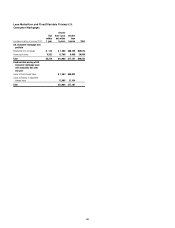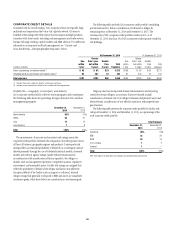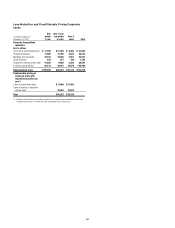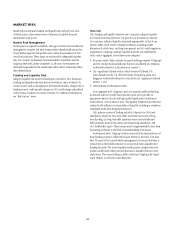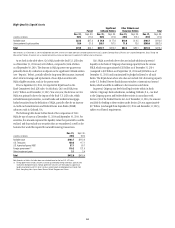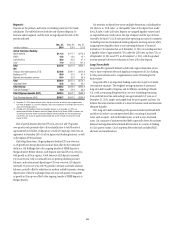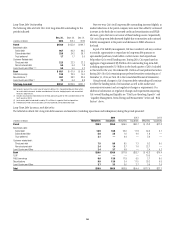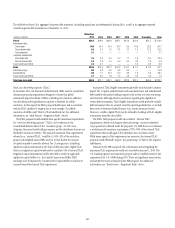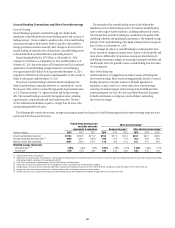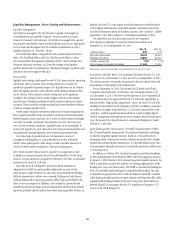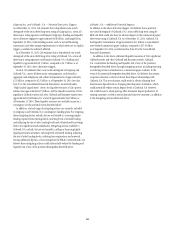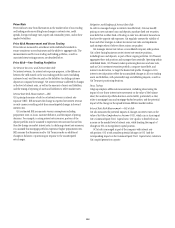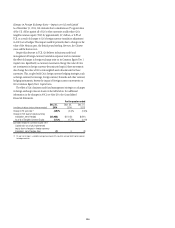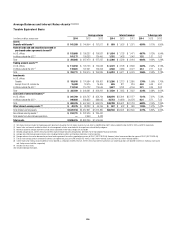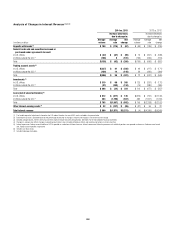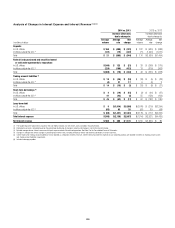Citibank 2014 Annual Report Download - page 116
Download and view the complete annual report
Please find page 116 of the 2014 Citibank annual report below. You can navigate through the pages in the report by either clicking on the pages listed below, or by using the keyword search tool below to find specific information within the annual report.
99
Liquidity Management, Stress Testing and Measurement
Liquidity Management
Citi’s HQLA is managed by the Citi Treasurer. Liquidity is managed via
a centralized treasury model by Corporate Treasury and by in-country
treasurers. Pursuant to this structure, Citi’s HQLA is managed with a goal of
ensuring the asset/liability match and that liquidity positions are appropriate
in every entity and throughout Citi (for additional information on Citi’s
liquidity objectives, see “Overview” above).
Citi’s Chief Risk Officer is responsible for the overall risk profile of Citi’s
HQLA. The Chief Risk Officer and Citi’s Chief Financial Officer co-chair
Citi’s Asset Liability Management Committee (ALCO), which includes Citi’s
Treasurer and senior executives. ALCO sets the strategy of the liquidity
portfolio and monitors its performance. Significant changes to portfolio asset
allocations need to be approved by ALCO.
Stress Testing
Liquidity stress testing is performed for each of Citi’s major entities, operating
subsidiaries and/or countries. Stress testing and scenario analyses are
intended to quantify the potential impact of a liquidity event on the balance
sheet and liquidity position, and to identify viable funding alternatives that
can be utilized. These scenarios include assumptions about significant
changes in key funding sources, market triggers (such as credit ratings),
potential uses of funding and political and economic conditions in certain
countries. These conditions include standard and stressed market conditions
as well as Company-specific events.
A wide range of liquidity stress tests is important for monitoring purposes.
These potential liquidity events are useful to ascertain potential mismatches
between liquidity sources and uses over a variety of time horizons (overnight,
one week, two weeks, one month, three months, one year, two years) and
over a variety of stressed conditions. Liquidity limits are set accordingly. To
monitor the liquidity of a unit, these stress tests and potential mismatches are
calculated with varying frequencies, with several tests performed daily.
Given the range of potential stresses, Citi maintains a series of
contingency funding plans on a consolidated basis and for individual
entities. These plans specify a wide range of readily available actions for a
variety of adverse market conditions or idiosyncratic disruptions.
Short-Term Liquidity Measurement; Liquidity Coverage Ratio (LCR)
In addition to internal measures that Citi has developed for a 30-day stress
scenario, Citi also monitors its liquidity by reference to the LCR, as calculated
pursuant to the final U.S. LCR rules.
Generally, the LCR is designed to ensure that banks maintain an
adequate level of HQLA to meet liquidity needs under an acute 30-day
stress scenario. Under the final U.S. rules, the LCR is calculated by dividing
HQLA by estimated net outflows over a stressed 30-day period, with the net
outflows determined by applying assumed outflow factors, prescribed in the
rules, to various categories of liabilities, such as deposits, unsecured and
secured wholesale borrowings, unused commitments and derivatives-related
exposures, partially offset by inflows from assets maturing within 30 days. In
addition, the final U.S. rules require that banks estimate net outflows based
on the highest individual day’s mismatch between contractual and certain
non-defined maturity inflows and outflows, known as the “peak day” outflow
requirement. Citi’s LCR is subject to a minimum requirement of 100%.
The table below sets forth the components of Citi’s estimated
LCR calculation and HQLA in excess of estimated net outflows as of
December 31, 2014 and September 30, 2014.
in billions of dollars
Dec. 31,
2014
Sept. 30,
2014
High quality liquid assets $ 412.6 $ 416.4
Estimated net outflows $ 368.6 $ 374.5
Liquidity coverage ratio 112% 111%
HQLA in excess of estimated net outflows $ 44.0 $ 42.0
Note: Amounts set forth in the table above are estimated based on the final U.S. LCR rules.
As set forth in the table above, Citi’s estimated LCR under the final U.S. LCR
rules was 112% as of December 31, 2014 and 111% as of September 30, 2014.
The increase quarter-over-quarter was primarily driven by deposit flows and
improvements in the quality of Citi’s deposit base.
Prior to September 30, 2014, Citi reported its LCR based on the Basel
Committee’s final LCR rules. On this basis, Citi’s estimated LCR was 117%
as of December 31, 2013. Year-over-year, the decrease in Citi’s estimated LCR
was primarily due to the impact of the final U.S. LCR rules. Specifically, as
discussed under “High Quality Liquid Assets” above, the final U.S. LCR rules
excluded certain assets from the calculation of HQLA. In addition, estimated
net outflows are higher under the final U.S. LCR rules, primarily due to the
“peak day” outflow requirement discussed above as well as higher deposit
outflow assumptions resulting from the more stringent deposit classifications
(e.g., the nature of the deposit balance or counterparty designation) under
the final U.S. LCR rules.
Long-Term Liquidity Measurement: Net Stable Funding Ratio (NSFR)
For 12-month liquidity stress periods, Citi uses several measures, including
its internal long-term liquidity measure, based on a 12-month scenario
assuming market, credit and economic conditions are moderately to highly
stressed with potential further deterioration. It is broadly defined as the ratio
of unencumbered liquidity resources to net stressed cumulative outflows over
a 12-month period.
In addition, in October 2014, the Basel Committee issued final standards
for the implementation of the Basel III NSFR, with full compliance required
by January 1, 2018. Similar to Citi’s internal long-term liquidity measure, the
NSFR is intended to measure the stability of a banking organization’s stable
funding over a one-year time horizon. The NSFR is calculated by dividing the
level of its available stable funding by its required stable funding. The ratio
is required to be greater than 100%. Under the Basel III standards, available
stable funding includes portions of equity, deposits and long-term debt, while
required stable funding includes the portion of long-term assets which are
deemed illiquid. Citi anticipates that the U.S. regulators will propose a U.S.
version of the NSFR during 2015.


